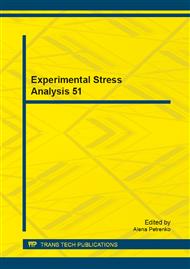p.3
p.9
p.16
p.20
p.26
p.32
p.36
p.42
Study of Residual Stress Surface Distribution on Laser Welded Steel Sheets
Abstract:
Advent of high power diode laser has substantially contributed to the popularity of laser welding in industry where its virtues such as low heat input and good weld strength are highly appreciated. However, one of the drawbacks of the laser welding is distortion of the welded bodies that is closely linked with the generation and/or redistribution of residual stresses in the vicinity of the weld. In this contribution, mapping of surface macroscopic residual stresses in two directions, i.e. parallel and perpendicular to the welds, were performed for two bodies. The first contained a weld created with the high power diode laser beam speed of 2 m/min and the second with the speed of 15 m/min. Our aim was to compare not only resulting fields of residual stresses, but also to perform qualitative assessment of the possible presence of crystallographic texture and gain a qualitative apprehension about the grain sizes in the vicinity of a laser weld joining two steel sheets. Larger distortion of the body with a laser weld is exhibited by the sample manufactured with approximately 8 times bigger speed of laser beam. This sample is in the immediate vicinity characterized by substantial compressive residual stresses in the direction perpendicular to the weld.
Info:
Periodical:
Pages:
3-8
Citation:
Online since:
December 2013
Authors:
Keywords:
Price:
Сopyright:
© 2014 Trans Tech Publications Ltd. All Rights Reserved
Share:
Citation:


